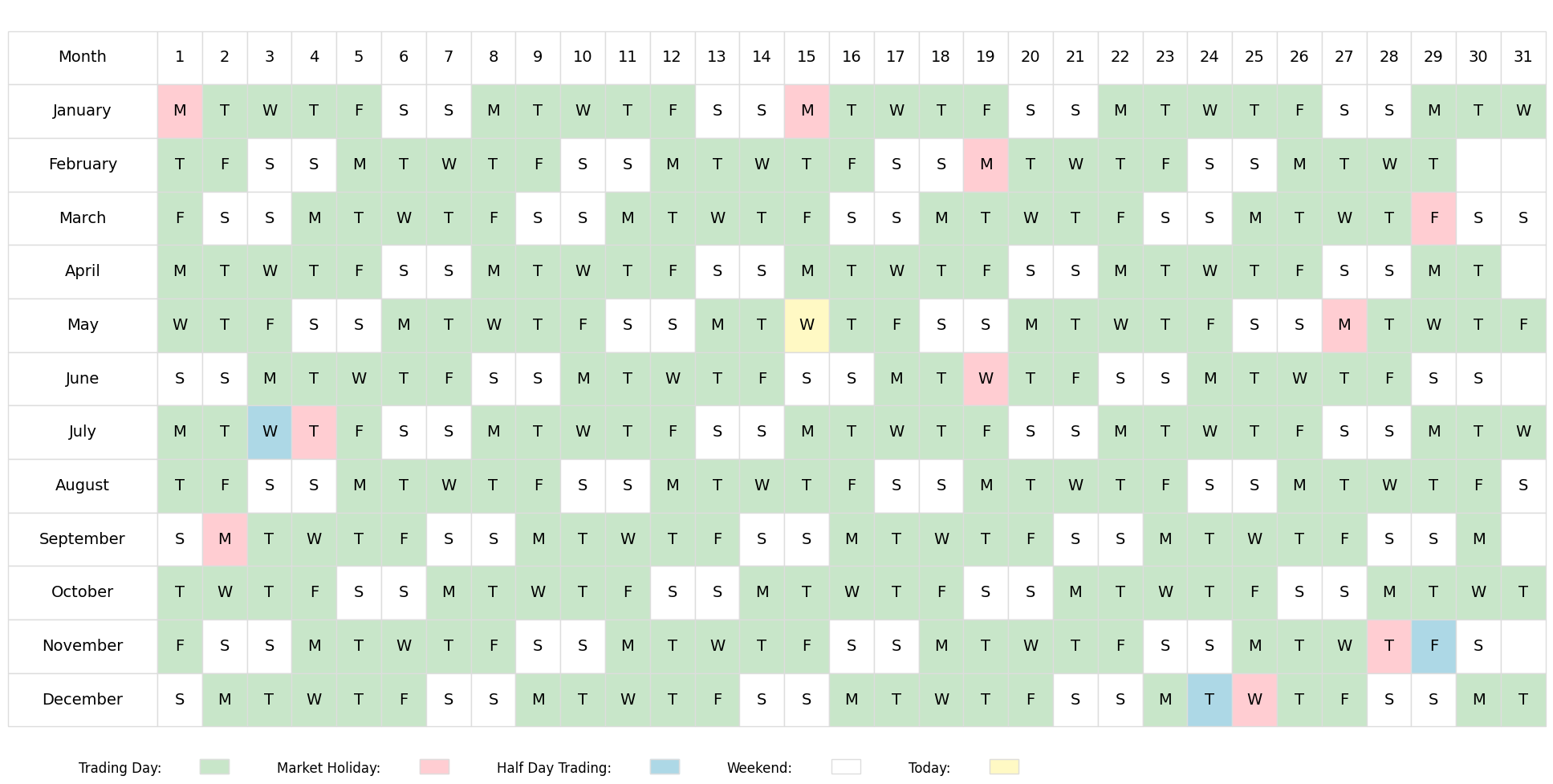Trading Days Calendar 2024¶
There is 252 total trading days in 2024. As of the next trading day, there are 171 trading days left. This month, there are 2 trading days left. The closest market holiday is on May 27, 2024 and it will be Memorial Day.
2024 Stock Market Holidays¶
| Date | Holiday |
|---|---|
| 2024-01-01 | New Year's Day |
| 2024-01-15 | Birthday of Martin Luther King, Jr. |
| 2024-02-19 | Washington's Birthday |
| 2024-03-29 | Market Holiday |
| 2024-05-27 | Memorial Day |
| 2024-06-19 | Juneteenth National Independence Day |
| 2024-07-03 | Half Day Trading |
| 2024-07-04 | Independence Day |
| 2024-09-02 | Labor Day |
| 2024-11-28 | Thanksgiving Day |
| 2024-11-29 | Half Day Trading |
| 2024-12-24 | Half Day Trading |
| 2024-12-25 | Christmas Day |
Trading Days Calculator¶
Trading Holidays Overview¶
In this section, we'll provide details on the days when stock markets close for holidays in 2024. We'll focus on when and why the markets observe these breaks, including key dates for the U.S. and international exchanges.
Understanding Market Holidays¶
Trading holidays are dates when stock markets close, allowing traders and investors a pause from the daily routine. In 2024, some of the major market holidays in the United States include New Year's Day (January 1), Memorial Day (last Monday in May), Juneteenth National Independence Day (June 19), Independence Day (July 4), Labor Day (first Monday in September), Thanksgiving Day (fourth Thursday in November), and others.
These holidays are observed by the NYSE, NASDAQ, and bond markets, as well as banks and government offices.
International Trading Holidays¶
Outside the U.S., different countries have their unique market holidays. Here are some key international holidays to be aware of in 2024:
- New Year's Day (January 1): This is a global holiday observed by most international markets.
- Bank Holidays: In the UK, bank holidays might not align with U.S. market holidays and vary year by year.
- Labor Day/October Golden Week: In markets like China, Labor Day or the National Day Golden Week in October can affect trading due to extended breaks.
We should note that while the above dates are generally accurate, they may vary slightly by market and locality, and it's essential for market participants to confirm specific dates each year.
Daily Trading Hours¶
Trading hours are a critical aspect to consider as they significantly impact our trading strategies and execution. Understanding the daily operational schedule of various exchanges ensures we are well-prepared to enter or exit trades within the active market periods.
Trading Sessions by Exchange¶
-
NYSE (New York Stock Exchange):
Regular trading hours for the NYSE are from 9:30 AM to 4:00 PM Eastern Time (ET), Monday through Friday. -
NASDAQ:
NASDAQ shares the same trading hours as the NYSE, operating between 9:30 AM and 4:00 PM ET.
*Both exchanges adhere to U.S. market holidays, on which trading is closed.
Early Closes and Extended Hours¶
-
Early Close Schedules:
Both the NYSE and NASDAQ occasionally close early, typically at 1:00 PM ET, in observance of certain U.S. holidays or special events. -
Extended Trading Hours:
- Pre-Market: 4:00 AM to 9:30 AM ET
- After-Hours: 4:00 PM to 8:00 PM ET
Extended hours allow us to act on information released outside the standard trading hours.
Timezone Considerations¶
When we engage with multiple exchanges across different time zones, we must account for variations in market hours. For instance, if we are located in the Pacific Time Zone, the NYSE and NASDAQ open at 6:30 AM and close at 1:00 PM local time. It's essential to adjust our schedules accordingly to align with the New York market's opening and closing times. Irregular schedules due to daylight saving time changes should also be monitored, as they can affect the exact opening and closing times of trading.
Calculating Trading Days¶
In the realm of finance, we must account for the actual number of trading days, not merely calendar days, and calculate settlement dates with precision. These values are crucial for accurate financial planning and the execution of trades.
When we evaluate the trading days in a year, it's essential to consider that not all weekdays are trading days. A standard year typically comprises 252 trading days in the stock market. However, this number can vary slightly each year due to holidays and weekends when markets are closed. To calculate how many trading days there is left in 2024 from end of any trading day, use our Trading Days Calculator
Calculating Settlement Dates¶
The term settlement date refers to the day a trade is legally settled, meaning the transfer of securities and funds is completed. To calculate this date, we use T+1, T+2, or T+3 conventions (where 'T' stands for the transaction date and the number denotes the number of trading days after T). For example, a T+2 settlement period would mean the settlement occurs two trading days after the transaction.
- T+1: Mostly used for certain types of securities transactions.
- T+2: Standard for most equity trades.
- T+3: Mainly for specific broker-dealers.
Our trading days calculator automates these calculations, taking into account weekends and holidays specific to the trading calendar to ensure the exact settlement date is identified. For instance, if we execute a trade on a Tuesday and the financial calendar shows a public holiday on Thursday, with a T+2 settlement, the settlement date would be Friday, not Thursday.
